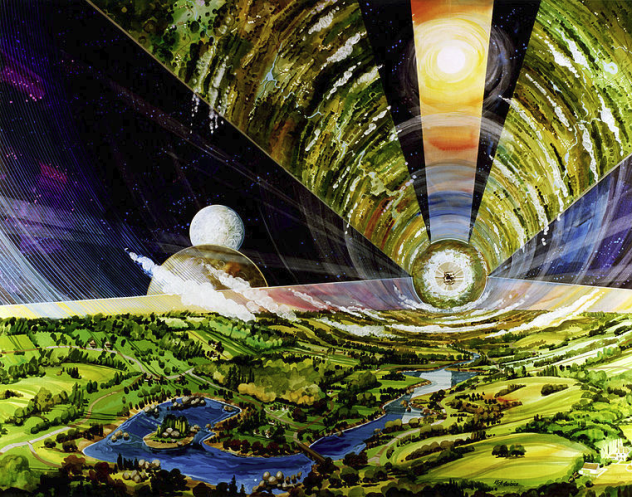 Politics
Politics  Politics
Politics  Weird Stuff
Weird Stuff 10 Freaky Times When Famous Body Parts Were Stolen
 Miscellaneous
Miscellaneous 10 Interesting Things Manufacturers Stopped Making and Why
 Gaming
Gaming 10 Funny Tutorials in Games
 History
History 10 Fascinating Little-Known Events in Mexican History
 Facts
Facts 10 Things You May Not Know about the Statue of Liberty
 Movies and TV
Movies and TV 10 Movie Adaptions That Brought Popular Songs to Life
 Health
Health 10 Miraculous Advances Toward Curing Incurable Diseases
 Miscellaneous
Miscellaneous 10 Undeniable Signs That People’s Views of Mushrooms Are Changing
 Animals
Animals 10 Strange Attempts to Smuggle Animals
 Politics
Politics 10 Countries Where Religion and Politics Are Inseparable
 Weird Stuff
Weird Stuff 10 Freaky Times When Famous Body Parts Were Stolen
 Miscellaneous
Miscellaneous 10 Interesting Things Manufacturers Stopped Making and Why
Who's Behind Listverse?

Jamie Frater
Head Editor
Jamie founded Listverse due to an insatiable desire to share fascinating, obscure, and bizarre facts. He has been a guest speaker on numerous national radio and television stations and is a five time published author.
More About Us Gaming
Gaming 10 Funny Tutorials in Games
 History
History 10 Fascinating Little-Known Events in Mexican History
 Facts
Facts 10 Things You May Not Know about the Statue of Liberty
 Movies and TV
Movies and TV 10 Movie Adaptions That Brought Popular Songs to Life
 Health
Health 10 Miraculous Advances Toward Curing Incurable Diseases
 Miscellaneous
Miscellaneous 10 Undeniable Signs That People’s Views of Mushrooms Are Changing
 Animals
Animals 10 Strange Attempts to Smuggle Animals
10 Radical Ideas To Colonize Our Solar System
What child hasn’t looked up into the night sky and wondered, just once, what life would be like on another planet? For all of human history, it seemed as if the infinite beauty of the cosmos could only be touched by our imaginations. Never before has man set foot on a planet besides our own.
That’s probably going to change sometime in the next 20 years. Mars hype is atmospheric right now, and the first person who walks on the fourth rock from the Sun likely will go down in history with the likes of Neil and Buzz. But while everyone’s seeing red, we’re forgetting the other possibilities hidden in our solar system.
10 Cloud Cities On Venus
Our sister planet Venus is a real ball-breaker. Its surface temperatures average about 500 degrees Celsius (900 °F), and the atmospheric pressure on the ground is close to 92 times that of Earth. Its cloud cover also contains pockets of sulfuric acid, but that’s not a major concern because the heat would probably kill you before the acid would have a chance to liquefy your skin. And according to NASA engineers Chris Jones and Dale Arney, this living hell might be one of our best shots at extraterrestrial colonization.
They propose building a colony of airships that would float about 50 kilometers (30 mi) over the surface. Just like Earth, Venus’s atmosphere thins the higher you go. At the height they’re suggesting, the atmospheric pressure would be comparable to Earth’s, and the temperature would hover right around 75 degrees Celsius (167 °F). For reference, the highest recorded temperature on Earth is 56.7 degrees Celsius (134 °F). It still wouldn’t be comfortable outside, but the temperature-controlled airships would be much easier to maintain. According to Chris Jones, the upper atmosphere of Venus is “probably the most Earth-like environment that’s out there.”
That’s a tantalizing claim for colonization fanatics, but how would it actually work? The early airships would be helium-filled zeppelins—a hanging gondola beneath an inflated balloon. That’s not exactly a revolutionary design, although the balloons would also be fitted with solar panels for harvesting the extreme sunlight that hits Venus. These balloons would be launched in capsules into Venus’s upper atmosphere, where they’d self-inflate and, hopefully, start floating before the dense lower atmosphere drags them down and kills everyone onboard.
9 Paraterraforming Ceres

Located in the asteroid belt between Mars and Jupiter, Ceres is a dwarf planet with a diameter of about 950 kilometers (590 mi). That gives it a surface area slightly larger than Argentina. It’s a big, icy rock smack-dab in the middle of nowhere with barely any gravity (2.8 percent of Earth’s).
Why would anyone want to go there? The thinking is that so far, Mars hasn’t turned up any particularly useful minerals, but Ceres is right in one of the most mineral-rich regions of the solar system. It could be used as a platform to harvest platinum and palladium, both valuable construction metals. Even better, there’s a good chance that that little rock contains more fresh water than Earth. That water could be harvested by colonists and turned into breathable oxygen and hydrogen fuel for rockets.
The only way it would be possible, though, is through something called paraterraforming. Since Ceres has such an itty-bitty atmosphere, astronauts would have to erect a transparent dome on the surface. As the colony grows, its inhabitants could add onto the dome with additional interlocking domes, spreading out their livable area until they cover the entire surface of Ceres like the multifaceted eyeball of an enormous space insect. Is it feasible? Probably not anytime soon, at least on that scale, but researchers have been able to successfully create a self-sufficient dome habitat on Earth, so it’s really just a matter of scaling up the technology and crossing your fingers that nothing will go wrong in the cold vacuum of space.
8 Concrete Homes On The Moon

Nobody’s been back to the Moon since the last Apollo lunar landing in 1972. It’s cold, dusty, and wholly inhospitable, a lunar landscape in the most literal sense. But that doesn’t mean it’s not worth returning to. According to a recent study commissioned by NASA, the cost of setting up a permanent colony on the Moon would be surprisingly inexpensive—a mere $10 billion instead of the originally assumed price tag of $100 billion. In terms of NASA’s budget, that makes it a project that they could start putting together right now.
The reasons for doing so are even more compelling. A base on the Moon would make both economical and logistical sense. It would be cheaper to launch long-range missions (think Mars) from the Moon, and most of the hydrogen and oxygen needed for rocket fuel could be mined directly from water at the lunar poles. Assuming we don’t run into any space Nazis, the Moon could be our golden ticket to the chocolate factory.
Where it gets crazy, though, is how we might build such a colony. Ideas range from inflatable pods wedged into lava tubes to space stations in lunar orbit, but the most insane of all would also be insanely simple—concrete homes. In 1992, Dr. Tung Dju Lin, a materials scientist, began studying the composition of a small piece of Moon rock he’d borrowed from NASA. He found that the lunar surface was already littered with everything that’s needed to create concrete. Specifically, the Moon has an abundance of a mineral called ilmenite, which contains both iron and titanium oxides. When Lin ground a bunch of Moon rock to powder and ran steam through it for a few hours, he created a slab of concrete which he claimed was stronger than its earthly counterpart. So as cool as it would be to live in high-tech Moon tubes, there’s a chance that we might just get a bungalow.
7Kuiper Disk Cities

Freeman Dyson is either a luminary or a crackpot, depending on how much you’ve been drinking. His credentials are solid. He’s been the recipient of the Lorentz medal and the Max Planck medal, as well as the Enrico Fermi Award, but his ideas tend to fall just outside the accepted scientific protocol of rational thought.
One of Freeman Dyson’s most famous ideas is the Dyson sphere, a megastructure designed to encapsulate a star, which would harvest energy for interstellar travel. But Dyson also had designs on other parts of the solar system, notably the Kuiper Belt, the comet-dense region beyond Neptune’s orbit.
In that region, comets often form heavily packed swarms that could be tethered to each other to create a city colony. As Dyson put it, “A Kuiper Belt metropolis would probably be a flat, disk-shaped collection of cometary objects, linked by long tethers and revolving slowly around the center to keep the tethers taut.”
Even if they weren’t linked, individually colonized comets would pass each other frequently, often within a million miles of each other, allowing colonists to hop from one meteor to another fairly easily. As for light and heat out there in the cold Kuiper world, Dyson suggests that an array of mirrors 100 kilometers (60 mi) wide would be able to provide 1,000 megawatts of solar energy.
6Bolo Habitats

In 1975, NASA conducted a study on the feasibility of different “free-space” habitats, colonies that weren’t tethered to any particular body. One of the designs they looked at was so simple that it could have been implemented right then—the bolo habitat.
Picture a string with a ball at either end, and you’ve got the basic idea. Each “ball” would be a sphere 22 meters (72 ft) in diameter that could house 10 people. The string in the middle would be 2 kilometers (1.2 mi) long, and the whole thing would rotate once every minute, giving the people inside something close to Earth gravity. Pack a solid 5 meters (16 ft) of Moon dirt around the outside of each sphere for a radiation shield, and you’ve got yourself a down-and-dirty space home.
Bolo habitats were envisioned as homestead colonies capable of providing everything a single family would need. There would be room to grow food, solar panels for power, and a manufacturing pod in the middle of the tether, a weightless environment to build more bolos. Just as settlers in the Old West expanded their homesteads to accommodate their growing families, pioneers in bolo habitats would be able to create entire cities of counterweighted, free-floating homes.
5Subsurface Ocean Pods On Europa

Europa has recently become geek-famous as the most likely place in the solar system to harbor extraterrestrial life. NASA’s taking the idea so seriously that they’re prepping an unmanned mission that will orbit Jupiter and conduct 45 flybys of the moon to look for telltale signs of life thriving in the salty ocean that’s supposed to exist beneath its surface. They hope to get the mission underway sometime in the 2020s.
But while it would be exciting to find tiny, bacteriological aliens clustered around geothermal vents deep beneath the surface of the Jovian snowball, one private company doesn’t want to wait for robots to do the dirty work; they want to get people there, and they want to do it within the next 50 years. Like Mars One, Objective Europa would be a one-way ticket, but sacrifice is useless unless you learn something along the way, and the project is going to have to leap some major hurdles to keep their astronauts alive long enough to unpack their test tubes.
Europa’s surface temperatures reach lows of – 170 degrees Celsius (–270 °F). It has no atmosphere (at least, no more than a pittance), and nearby Jupiter bombards the moon with a lethal radiation dose of 540 rem on a daily basis. To overcome those problems, Objective Europa wants to keep their team underground. After establishing a short-term surface base, the team would have to drill down through the ice crust to reach the warmer temperatures of the ocean below. There, or somewhere in the connecting ice tunnel, they’d be able to establish an underground base inside permanent air bubbles. Here’s a technical schematic of what it would look like.
4Free-Floating O’Neill Cylinders

An O’Neill cylinder is a massive tube, 32 kilometers (20 mi) long and 8 kilometers (5 mi) in diameter, that rotates to simulate gravity. Built in connected, oppositely rotating pairs, each cylinder would, in theory, be able to house 10 million people.
This idea has been around since 1974, ever since physicist Gerard K. O’Neill outlined the concept in an article in Physics Today. Back then, of course, it was an idea firmly entrenched in science fiction. We’d barely been to the Moon, so it was unlikely that we’d just turn around and build a cosmic megastructure to house millions of people. However, O’Neill’s idea sparked something in the scientific community’s collective consciousness, and the concept has refused to die.
O’Neill cylinders are still outside our technological grasp, but as so often happens, science is quickly catching up to the fiction. According to the British Interplanetary Society, a group that predicted a practical lunar mission 30 years before the Apollo program, we could actually build an O’Neill cylinder today. The only real problem is getting someone to pay for it. Most of the materials needed to construct the cylinders would be mined from the Moon, and the advent of less expensive spacecraft like Reaction Engines’s Skylon would facilitate construction.
3Bigelow Aerospace’s Balloon Stations
As the single most expensive object ever built and the largest artificial satellite in orbit around Earth, the International Space Station (ISS) is a beacon of human progress that required the cooperation of two dozen nations and over $160 billion in funding. Since 2000, its crews have conducted groundbreaking research in microgravity, cosmic radiation, biotechnology, and dark energy, just to name a few.
When Robert Bigelow, a Vegas real estate tycoon, saw the ISS in action, he had only one thought: “I can do better.” So he started Bigelow Aerospace with a $500 million bankroll from his own pocket to research and build commercial space stations for a fraction of the price. While the ISS was assembled piece-by-piece in space over a two-year period, Bigelow’s B330 takes a simpler approach: It’s a massive balloon stuffed in the nose cone of a rocket. Once the rocket clears the atmosphere, the balloon inflates into a fully realized space station capable of housing a crew of six.
It’s a radical idea, but is it crazy? Maybe not; Bigelow already has two inflatable space station modules in orbit, the Genesis I and the Genesis II, and plans are underway to launch the larger Space Complex Bravo in 2016. And Robert Bigelow isn’t stopping with our local neighborhood. His vision for the future of his ballooning business includes lunar colonies, deep-space stations, and Martian outposts.
2Bubbleworlds
Long before Gerard O’Neill published the first description of his rotating cylinders, NASA scientist Dandridge Cole proposed a similar concept, which he called a “bubbleworld.” While O’Neill’s cylinders were built from scratch using materials scavenged from the Moon, Cole’s idea was much more metal.
First, we’d have to find an asteroid made mostly of metal, preferably one of the more malleable alloys like nickel-iron. That’s easy enough; there are thousands of them all around us. The next step would be to drill a tunnel through the center of the asteroid and fill it with water, and then use concentrated solar heat to fuse the ends of the tunnel closed. Dialing back the solar focus, we’d then slowly soften the asteroid’s metal body, simultaneously boiling the water inside so that the steam would inflate the asteroid’s softened shell and hollow out the interior.
After it cooled, mirrors could reflect sunlight into the hollow interior, spin could be induced to simulate gravity, and people could live on the inside surface.
1Bioengineered Trees

Imagine an immense tree growing out of a comet. Its roots fill the cracks and seams that run through the comet’s interior, its canopy forms a protective umbrella around the outside, and its hollow trunk is filled with bustling human colonists.
Welcome back to the mind of Freeman Dyson.
In a 1997 essay for The Atlantic entitled “Warm-Blooded Plants and Freeze-Dried Fish,” Dyson outlined a plan to use bioengineered “greenhouse trees” to provide habitats for human colonies in space. The essay reads like a child who dreamed of rocket ships and spaceflight finally grew up but forgot to stop dreaming. In the paper, he describes the steps required to colonize a meteor with this method. As with most great things, mankind’s journey into the cosmos would begin with a seed.
Once it hit the surface of a comet, according to Dyson, this seed would grow into a huge, warm-blooded plant that would be bioengineered to survive in subzero temperatures using only the light from the distant Sun. There, the tree would grow large enough to form a warm, enclosed habitat filled with oxygen from its natural photosynthesis. By the time humans arrived, their home would already exist within the greenhouse tree.
Eli Nixon is the author of Son of Tesla and Nightmare Machines. Follow him on Twitter.








